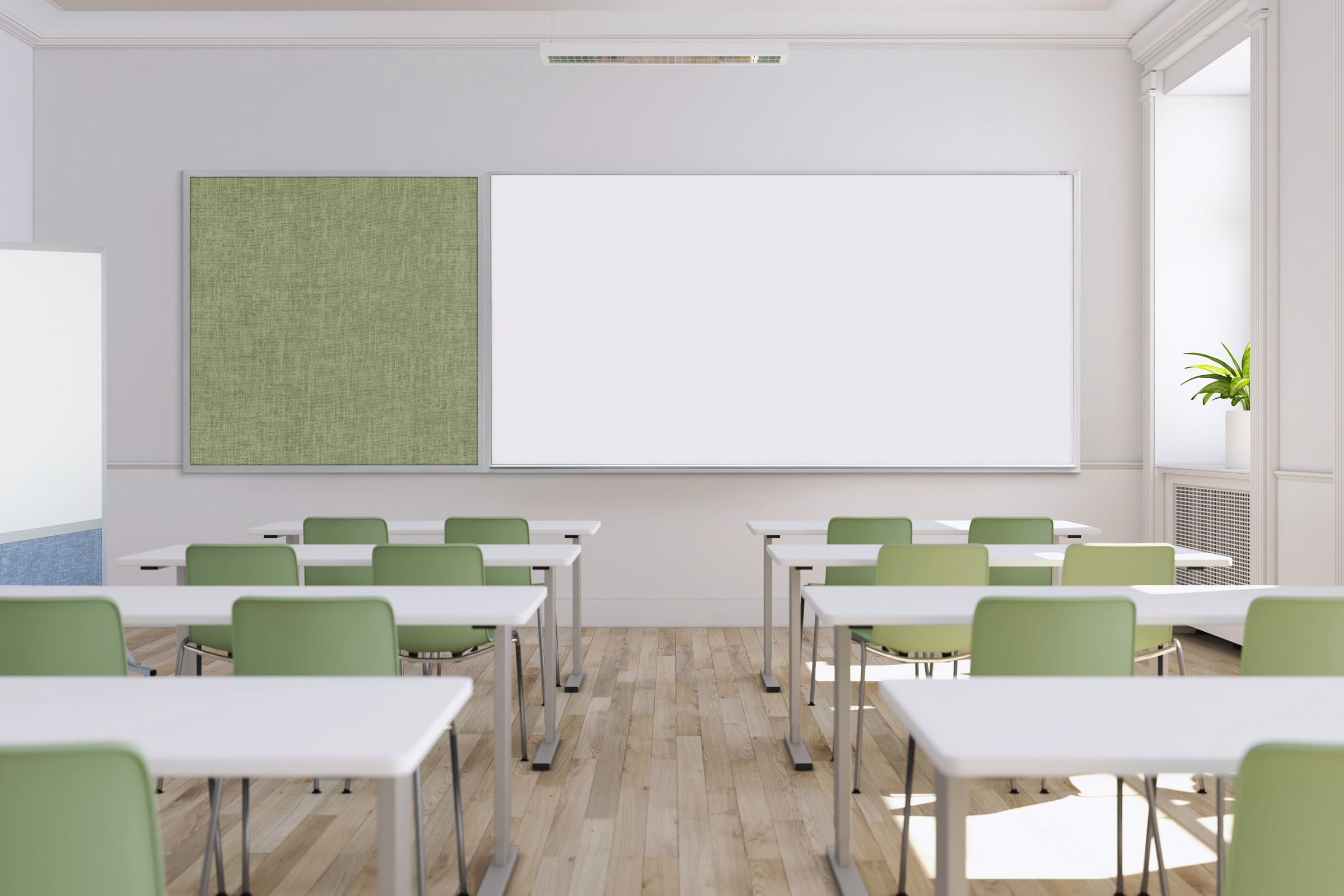Story at a glance:
- Architects should consider how they’ll incorporate visual display products into their projects in the early phases of design.
- The move toward collaborative learning and working environments means visual display boards are more popular than ever.
- Understanding the functionality of various materials and products offers a greater opportunity for combining solutions.
For many of us, chalkboards have long been the primary visual representation of our time in school. You can probably remember the distinct feeling of trying to wipe chalk off of your hands after writing on the board in front of class. Yet today’s students will likely have far different memories.
Today, most educational institutions have moved toward cleaner, more functional visual display solutions such as marker and projector boards. Even many offices now employ these types of visual display systems, which provide workers with a simple tool to collaborate and exchange information.
“Over the years we’ve learned that combining verbal with visual communications has facilitated students’ and workers’ ability to understand better and faster,” says Bill Singhaus, manager of sales and marketing at Marsh by Polyvision, a leading manufacturer of visual display systems.
Marsh is quite familiar with the evolution of the visual display market. The firm, which started as a lumber company in 1914, launched the Marsh Chalkboard Division in 1958—the origin of its current suite of products.
Technologies evolve and client needs change, but “I think one of the things that has really made Marsh unique in the education market is that we’ve really stayed true to our core business,” Singhaus says. Its visual display board products are made from high-quality CeramicSteel™ or glass, framed in either wood or aluminum, and are customizable to fit any need.
Singhaus recently sat down with gb&d to discuss how architects and designers can best utilize visual display systems in the education and commercial office markets.
Consider Your Space

Tack boards can be made from cork, burlap, or vinyl and are often paired with marker boards for their complementary functionalities—especially in the classroom setting. Photo courtesy of Marsh by PolyVision
When is the ideal time to begin considering how best to incorporate visual display products into your design? “The earlier, the better,” Singhaus says. “Visual display systems are often an afterthought for architects, but knowing the needs of the client early on means less hassle later in the process.”
Singhaus spends a good amount of time during the discovery phase of a project catching the architects and interior designers up to speed on the latest trends and technologies in the industry. This is a great place for designers to start, especially for those who don’t work with visual display products regularly.
Next, architects need to work with the manufacturer to get a better understanding of how the client will be utilizing the visual display systems. In a school, display boards are generally installed “simultaneously with other accessories such as lockers and bathroom partitions” toward the end of the construction timeline, Singhaus says. Yet the planning for their placement in the classroom should be considered much earlier than this, so their positioning doesn’t conflict with other considerations like switches, plugs, and system sensors.
Identify Your Needs

Marsh Pro-Jex visual display board system. Photo courtesy of Marsh by PolyVision
Whether you’re incorporating a visual display board system into an educational space or commercial office project, it’s important to put yourself in the shoes of the client to fully consider their needs and how they’ll interact with the space.
“That means hearing from the teachers and employees who will be directly utilizing these systems, not just the administrators or the C-suite,” Singhaus says. Skipping this step can lead to a finished product that is visually appealing, but lacking in its functional potential.
For example, “when you talk to teachers, they believe the display boards in their classrooms are the most important teaching tools they have,” Singhaus says. “So understanding exactly how they’ll use these tools is critical.”
Many teachers now prefer full-wall visual display solutions, where a portion of the classroom wall is wrapped in markerboard—allowing all students to participate in the collaborative learning process. “This is really one of the biggest trends in the industry, especially as we begin to understand more of the benefits of collaborative learning,” Singhaus says.
Mobility is another area of rising importance in both the education and office markets, which is why Marsh offers an entire suite of double-sided, magnetic mobile boards. The flexibility that these offer further enhances classroom participation and engagement by allowing students to work through problems together in small groups. “You can reconfigure the classroom setup six or seven times in a day” with the mobile boards, Singhaus says.
Naturally, the specific needs of a commercial office space are much different than those in the education market, but overall, enhancing collaboration and mobility are still key. “Even with the trend of shrinking offices, commercial tenants are still looking to increase their collaborative workspaces,” Singhaus says. “They require even more flexibility now because of the pandemic.” This often means using mobile whiteboards not only to write on, but also to physically divide open office formats.
Explore All Use Cases

Peb-Tac Bulletin boards are made with natural cork and provide a ideal resilience for display purposes. Pair side-by-side with a Pro-Rite markerboard or install in a common area for announcements and accolades. Photo courtesy of Marsh by PolyVision
Today, schools typically employ a combination of markerboards, projection boards, and tack boards. “Each of these solutions offers its own distinctive benefits,” Singhaus says. “For the architect or interior designer, the goal is to understand how each is best utilized and incorporate the ideal combination of solutions into the project.”
Traditional whiteboards, such as Marsh’s Pro-Rite Markerboards, are by far the most popular and flexible solution in the market. Made from CeramicSteel, “the marker boards are the workhorses of the visual display market,” Singhaus says. They’re incredibly durable and utilitarian, yet visually appealing.
Schools, daycares, and universities also continue to employ tack boards as a critical learning tool. Tack boards can be made from cork, burlap, or vinyl and are often paired with marker boards for their complementary functionalities—especially in the classroom setting.
And while functionality is key for designing an educational space, many commercial office tenants place an equal—if not a greater—premium on form and aesthetics. For these clients Singhaus points to the growing popularity of its Pro-Rite Glassboards. “These offer the fresh, contemporary look that many corporate office tenants are prioritizing,” Singhaus says.
They’re made from quarter-inch thick Starphire tempered glass and offer many of the same functionalities as the traditional marker boards, with a slightly more refined look—and the ability to add customizable logos and graphics. There is also the option to equip the glass boards with an anti-reflective matte finish, which alleviates any potential visual interruptions.
Projection boards can be easily incorporated into any of these systems. “The benefit of the projection board is that it gives you the best image size and clarity,” Singhaus says. Marsh’s Pro-Jex Projection Boards stand 5 feet tall to maximize projection area and offer excellent light diffusion for a far superior image quality.
Projection boards have been popular in schools and are gaining traction across the commercial office sector, especially as companies increasingly connect with clients and colleagues via remote meeting technologies like Zoom. “With the sector moving toward virtual meetings, with some staff in the meeting space and others appearing on a projector on the wall, you really want the highest quality available.”
And while chalkboards may no longer be popular in schools, restaurants, cafes, and breweries are increasingly turning to this solution for displaying their menus and daily specials. “It gives the space a rustic flair that is very popular in the hospitality industry,” Singhaus says.
Anticipate Future Trends
If there is one lesson from the global pandemic for architects, designers, and builders, it’s that the industry must anticipate the unexpected and adjust their plans accordingly. If you’d asked an architect in 2019 what the biggest trend in the commercial real estate market was, they likely would have pointed out the move toward open office formats. Two years later, and the pandemic is causing office workers to yearn for the days of the partitioned cubicle.
Yet this reversal also presents an opportunity for savvy designers. Companies are increasingly focused on adding collaborative work areas in order to facilitate hybrid work models, where perhaps 200 employees might share only 50 seats on a scheduled rotation.
“This is a big plus for us in the industry, because display boards are absolutely critical to fostering a collaborative work environment,” Singhaus says. Architects must anticipate and adapt as these broader trends in the marketplace evolve so they’re not designing a solution that will soon become obsolete.
The flip side of this move toward a hybrid work model is that more people than ever are working from home and upgrading their home offices accordingly. Designers who once exclusively operated in the commercial office market may want to consider expanding into the home office segment as more people ditch the daily commute.
“Work-from-home is probably here to stay, and these customers are going to have very different needs than traditional office tenants,” Singhaus says. “Being farsighted and pivoting your business accordingly will pay dividends.”


